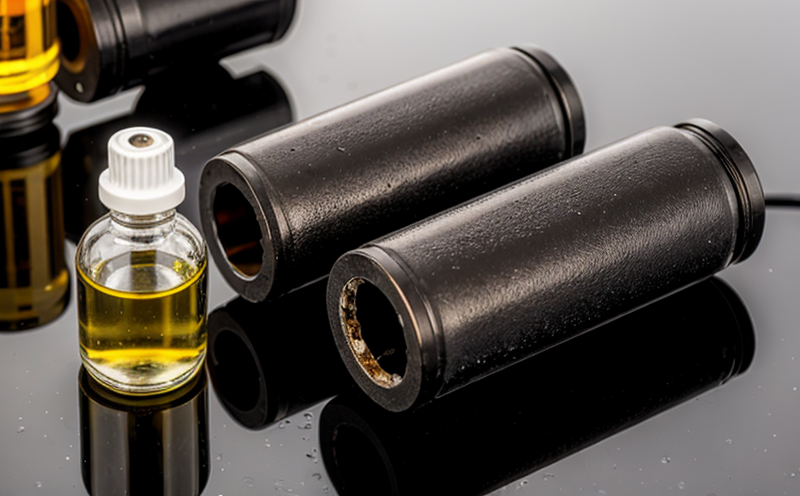EPA 8015D Petroleum Hydrocarbon Extended Test in Water
The EPA Method 8015D is a standardized test used to determine the concentration of petroleum hydrocarbons, including oil and grease, in water samples. This method is widely utilized by environmental agencies, quality managers, compliance officers, and R&D engineers responsible for assessing contamination levels in water bodies.
The EPA 8015D involves several steps that ensure accurate measurement of hydrocarbon content. The process begins with the collection of a representative water sample from the source of concern. After sampling, the water is treated to remove particulates and suspended solids using filtration techniques such as centrifugation or membrane filtration.
The filtered water is then divided into aliquots for different analyses. One aliquot undergoes an extraction process where it is mixed with a solvent that effectively dissolves hydrocarbons from the sample matrix. Common solvents used include dichloromethane and methylene chloride, which are chosen based on their ability to extract oil and grease without affecting other constituents in the water.
The extracted phases are separated using liquid-liquid extraction techniques or solid-phase extraction cartridges designed specifically for petroleum hydrocarbons. Once separation is complete, the organic layer containing the hydrocarbons is analyzed by gas chromatography (GC) coupled with flame ionization detection (FID). This combination provides high sensitivity and selectivity necessary to quantify trace levels of hydrocarbons.
The GC-FID system separates individual components within the petroleum fraction according to their boiling points. Identification of specific compounds relies on retention times compared against a library of known standards. Quantification is achieved through peak area measurements which correlate directly with concentration values derived from calibration curves prepared using certified reference materials.
Results obtained from this method are reported in milligrams per liter (mg/L) or parts per million (ppm), depending on the scale of contamination being addressed. Reporting includes both total petroleum hydrocarbon content as well as individual component breakdowns when relevant. This information is crucial for regulatory compliance purposes but also aids in source identification and remediation efforts.
Accurate interpretation of results requires understanding that different types of oil have varying physical properties which can affect extraction efficiency and peak shapes observed during GC analysis. Additionally, factors such as temperature variations during sample handling or storage conditions may influence final concentrations reported by the test.
Applied Standards
| Standard | Description |
|---|---|
| EPA Method 8015D | This method specifies procedures for determining the total petroleum hydrocarbons in water by solvent extraction and gas chromatography. |
| ASTM D6379-14 | American Society for Testing and Materials standard practice for the use of solid-phase extraction cartridges. |
| ISO 20854:2015 | International Organization for Standardization guideline on methods for sampling and analysis of hydrocarbons in water. |
| IEC 62321-1:2017 | International Electrotechnical Commission specification for gas chromatographs used in environmental monitoring. |
International Acceptance and Recognition
The EPA Method 8015D has gained international recognition due to its rigorous scientific foundation and consistent performance across various laboratories. Regulatory bodies worldwide, including those in Europe (such as the European Commission) and Asia-Pacific regions, have adopted this method for monitoring oil pollution levels.
International organizations like the World Health Organization (WHO), United Nations Environment Programme (UNEP), and International Maritime Organization (IMO) recommend the use of EPA 8015D when conducting assessments related to hydrocarbon contamination in aquatic environments. Compliance with these methods ensures harmonization among countries involved in international environmental agreements.
Many industries operating globally, particularly those involved in shipping, offshore oil production, and waste management, rely on standardized testing procedures such as EPA 8015D to meet regulatory requirements set forth by national governments or international conventions like MARPOL Annex I.
Use Cases and Application Examples
The application of the EPA Method 8015D extends beyond mere compliance; it plays a pivotal role in environmental protection strategies. Here are some practical scenarios where this method finds utility:
- Oil Spill Response: Following an accidental release into water bodies, agencies can use EPA 8015D to assess the extent of contamination and guide clean-up operations.
- Drinking Water Quality Control: Regular testing helps maintain public health standards by ensuring that drinking water does not contain excessive amounts of hydrocarbons harmful to human consumption.
- Industrial Effluent Monitoring: Manufacturing plants releasing wastewater into nearby rivers or lakes must adhere to strict limits on petroleum content. EPA 8015D provides precise data needed for continuous monitoring and process optimization.
In each case, accurate measurement of petroleum hydrocarbons is essential not only for meeting legal obligations but also for safeguarding ecosystems and human health.





